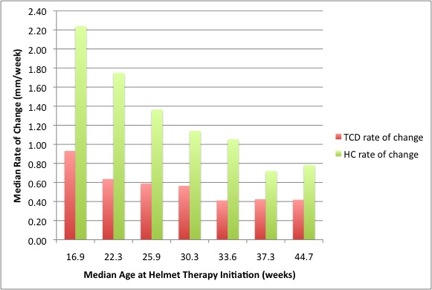|
|
 |
Back to Annual Meeting Program
Helmet Treatment of Deformational Plagiocephaly: The Relationship Between Age at Initiation and Rate of Correction
Mitchel Seruya, MD1, Albert Oh, MD2, Jonathan Taylor3, Tina Sauerhammer, MD2, Gary Rogers, MD, JD, MBA, MPH2.
1Georgetown University Hospital, Washington, DC, USA, 2Children's National Medical Center, Washington, DC, USA, 3Boston Brace, Avon, MA, USA.
BACKGROUND: The purpose of this study was to evaluate the relationship between age at initiation of helmet therapy for deformational plagiocephaly and the rate of correction.
METHODS: Infants treated for deformational plagiocephaly with a helmet orthosis between 2009 and 2010 were included. Patients were prospectively stratified by the age treatment was initiated - Group 1: under 20 weeks (N=26); Group 2: 20-24 weeks (N=59); Group 3: 24-28 weeks (N=82); Group 4: 28-32 weeks (N=62); Group 5: 32-36 weeks (N=45); Group 6: 36-40 weeks (N=29); Group 7: greater than 40 weeks (N=43). Pre and post treatment calvarial asymmetry was measured using direct anthropometry and reported as a transcranial difference (TCD).
RESULTS: 346 infants were included; initial TCD was equivalent on all paired-group comparisons. Duration of helmet therapy positively correlated with age at initiation (r = 0.89, p < 0.05). The rate of change in TCD negatively correlated with age at treatment onset (r = -0.88, p < 0.05): Group 1, 0.93 mm/week; Group 2: 0.64 mm/week; Group 3: 0.59 mm/week; Group 4: 0.56 mm/week; Group 5: 0.41 mm/week; Group 6: 0.42 mm/week; Group 7: 0.42 mm/week). The decrease in the rate of correction of calvarial asymmetry mirrored a logarithmic decline in head circumference growth (Figure). At the conclusion of therapy, all groups had improved calvarial symmetry, albeit less completely in groups 6 and 7.
CONCLUSIONS: The correction rate of plagiocephaly with helmet therapy decreases with increasing infant age; after 32 weeks, there is a slow and relatively constant rate of change. Improvement can still be achieved in infants older that 12 months of age. 
Back to Annual Meeting Program
|







